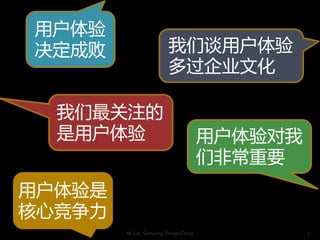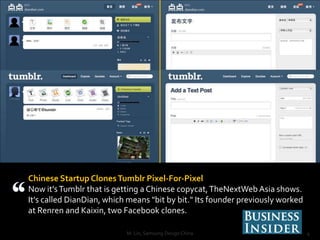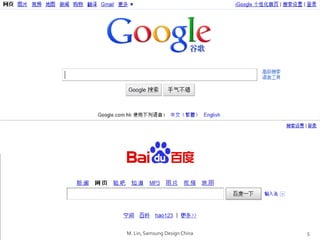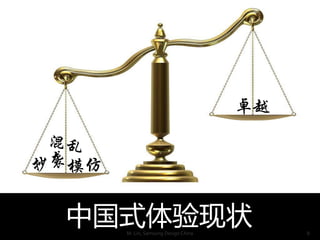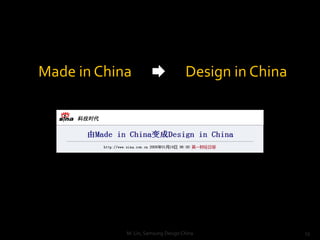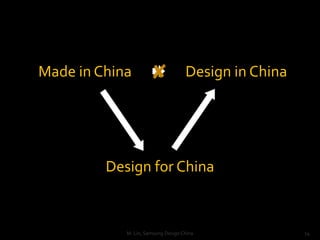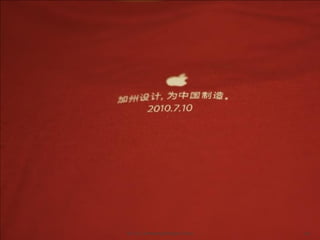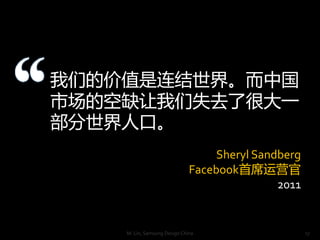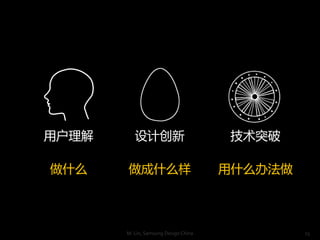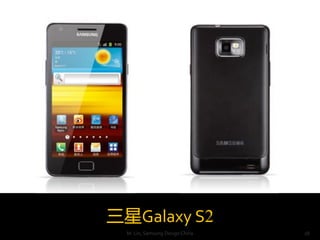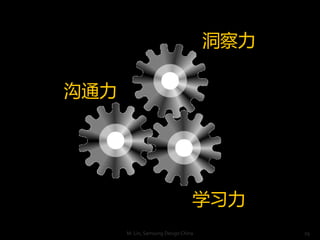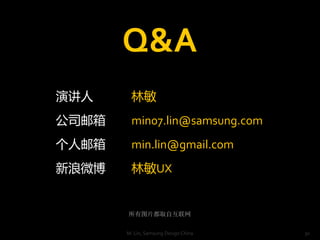非常道 走出中國式體驗的迷失 三星
- 1. 走出中国式体验的迷失 林 敏 博士 三星中国设计研究所
- 2. 用户体验 决定成败 我们谈用户体验 多过公司文化 我们最关注的 是用户体验 用户体验对我 们非常重要 用户体验是 核心竞争力 M. Lin, Samsung Design China 2
- 3. 图片版权:治图传媒 M. Lin, Samsung Design China 3
- 4. Chinese Startup Clones Tumblr Pixel-For-Pixel Now it's Tumblr that is getting a Chinese copycat, TheNextWeb Asia shows. It's called DianDian, which means "bit by bit." Its founder previously worked at Renren and Kaixin, two Facebook clones. M. Lin, Samsung Design China 4
- 5. M. Lin, Samsung Design China 5
- 6. M. Lin, Samsung Design China 6
- 7. M. Lin, Samsung Design China 7
- 8. 中国式体验现状 M. Lin, Samsung Design China 8
- 9. M. Lin, Samsung Design China 9
- 10. M. Lin, Samsung Design China 10
- 11. 入门靠偶遇 实践靠耐心 提高靠悟性 获奖靠概念 M. Lin, Samsung Design China 11
- 12. 成熟度 体验设计 用户体验 交互设计 HCI Usability 可用性 时间 M. Lin, Samsung Design China 12
- 13. Made in China Design in China M. Lin, Samsung Design China 13
- 14. Made in China Design in China Design for China M. Lin, Samsung Design China 14
- 15. 2010 雪铁龙 Metropolis M. Lin, Samsung Design China 15
- 16. M. Lin, Samsung Design China 16
- 17. 我们的价值是连结世界。而中国 市场的空缺让我们失去了很大一 部分世界人口。 Sheryl Sandberg Facebook首席运营官 2011 M. Lin, Samsung Design China 17
- 18. M. Lin, Samsung Design China 18
- 19. M. Lin, Samsung Design China 19
- 20. 恐慌心理 不思考 从众心理 侥幸心理 投机 功利心理 M. Lin, Samsung Design China 20
- 21. “…就是这样做的” “…说要这样做” “…在网上找不到” “过得去就行了” “…总是不配合” “应该不会有事的” M. Lin, Samsung Design China 21
- 22. M. Lin, Samsung Design China 22
- 23. 用户理解 设计创新 技术突破 做什么 做成什么样 用什么办法做 M. Lin, Samsung Design China 23
- 24. 用户理解 设计创新 技术突破 深 点 强 中国式体验 M. Lin, Samsung Design China 24
- 25. 照片来源:PChome.net 用户行为 用户洞察 市场机会 产物机会 设计建议 M. Lin, Samsung Design China 25
- 26. 设计战略 设计分析 设计机会 设计灵感 设计创新 M. Lin, Samsung Design China 26
- 27. 联想乐Phone M. Lin, Samsung Design China 27
- 28. 三星Galaxy S2 M. Lin, Samsung Design China 28
- 29. 洞察力 沟通力 学习力 M. Lin, Samsung Design China 29
- 30. Q&A 演讲人 林敏 公司邮箱 min07.lin@samsung.com 个人邮箱 min.lin@gmail.com 新浪微博 林敏UX 所有图片都取自互联网 M. Lin, Samsung Design China 30

